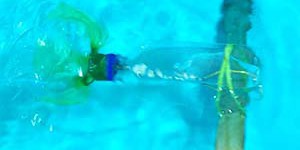Fifth Grade, Aerodynamics & Hydrodynamics Science Projects (28 results)
You've seen for yourself, or in videos, planes flying, rockets hurdling towards space, boats racing through the water and submarines exploring the depths of the ocean. Have you ever stopped and thought about the aerodynamics and hydrodynamics involved in their operation? There is a lot of interesting science that goes into how they work!
|
Select a resource
Coding Projects
Sort by
|
Alternative energy sources are a big deal these days. One such source is the wind. Find out how a wind turbine can use the power of the wind to generate energy in this science fair engineering project. You'll design various blades to find out which produces the most energy, and put the wind to work for you!
Read more
How does a parachute work? Do bigger parachutes work better than smaller parachutes? Find out in this science project if the size of the parachute matters.
Read more
New
How do you feel right now? Do you remember how you felt a few hours ago? How about yesterday or last Wednesday? What if you could track your emotions throughout the day and use this information to help improve your mood and well-being? In this science project, you will program a simple, pocket-sized device that you can carry around with you to log your feelings whenever you want or on a specific schedule.
Read more
How does weight affect a drone's speed? Is there a limit to how much weight a drone can lift? Find out with your own mini popsicle stick drone in this fun science project!
Read more
Have you ever ridden on a carousel, or a merry-go-round, at an amusement park? On a carousel, you usually get to take a seat on a wooden horse or other animal that spins around and around as the carousel is turned on and powered by electricity. Another smaller type of carousel that people can have in their homes is a candle carousel, which is powered by heat from candles. In this science project, you will get to make your own candle carousel and investigate how the spinning speed of the…
Read more
Do you dream about making deep, undersea voyages? Let this project take you 20,000 leagues under the sea! Investigate how submarines dive and surface by changing their buoyancy in this fun project.
Read more
New
Have you ever walked next to your favorite ocean, lake, or creek and seen plastic waste everywhere? Have you ever thought about how much plastic breaks down into microplastics and pollutes waterways? Scientists are coming up with new ways to remove these microplastics from our waterways, and now you can test them out for yourself at home.
Read more
Have you ever wondered how a ship made of steel can float? Or better yet, how can a steel ship carry a heavy load without sinking? In this science project you will make little "boats" out of aluminum foil to investigate how their size and shape affects much weight they can carry and how this relates to the density of water.
Read more
Have you ever looked up into the sky and seen not a bird, not a plane, but a hot-air balloon? They are definitely amazing and fun to watch! Do you think they are all the same size? Does size affect how long the hot-air balloon can fly? In this science fair project, you will launch hot-air balloons, powered by a toaster, and see how the size of the balloon affects its flight.
Read more
What keeps a model rocket on course? How can you make sure a model rocket design is stable before you launch it? Find out in this project as you learn about center of mass, center of pressure, and their effect on a rocket's stability.
Read more
Have you ever seen butterflies fluttering around outside, gliding through the air and landing on flowers? While they are delicate and fragile, butterflies are actually excellent flyers. They are so good, in fact, that scientists at Harvard University studied butterfly wing shapes as an inspiration for building a miniature flying robot. In this science project, you will do your own version of the Harvard scientists' experiment to measure the flight performance of butterfly wings.
Read more
What keeps a submarine from spinning out of control? In this science project, you can investigate how
submarines use stabilizing fins to move forward. You might even figure out the secrets to maneuvering a submarine!
Read more
|

















